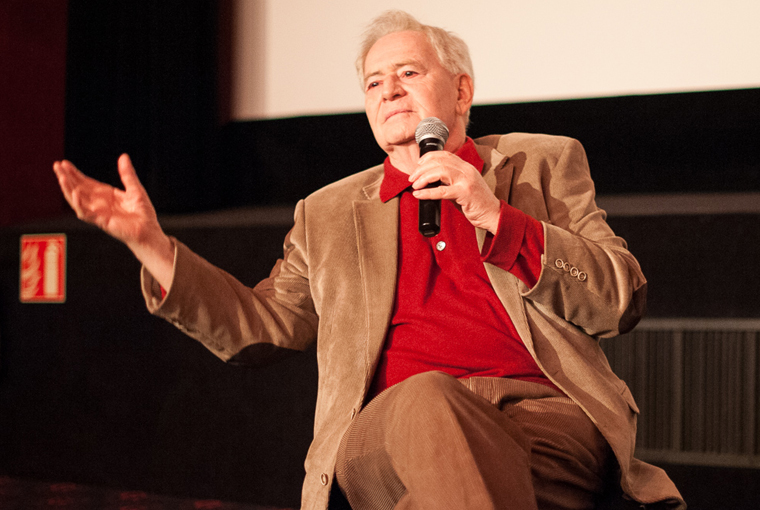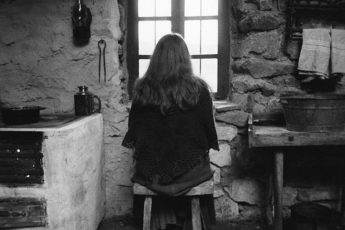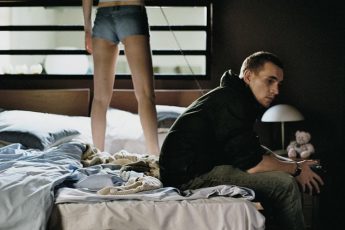
EEFB’s Moritz Pfeifer animated the masterclass with István Szabó during this year’s A l’Est du Nouveau (11-18 April). Szabó gives insightful lessons on how to film history, on how to adapt a novel to the screen, and talks about his relationship with his home country, Hungary. Below are some excerpts of the masterclass.
What are the most important things to consider when making a film about history?
That depends on what you mean with history. From today’s perspective, everything that happened yesterday is part of history – it happened and it cannot be changed. But if you want to make a movie or write a novel, you have to find something that is also important today. I’m only interested in telling stories that take place in the past if I can find questions and answers in them that are important for us today.
What are the differences between treating history in a movie and in a novel?
I always tried to look for emotions and found that there a few things as forceful as the close-up of a human face. That’s all there is. Everybody smiles differently. You can hardly describe a smile or paint it, at least only one moment of it. Being able to show the life of a face with all its transformations and changing emotions is what cinema is for me: the close-up of a hero and his antagonist.
In many films of yours, protagonist and antagonist overlap. Are Colonel Redl and Hendrik Höfgen protagonists or antagonists?
Well, you have to know that the emperor Franz Joseph did not really like Franz Ferdinand because he did not have the right personality to become an emperor. In the movie, he says at one point that “the emperor’s Waltz is finished” so he was against Franz Joseph’s rather liberal politics. So I wanted to show someone who fights for having power, who is cynical and cold. Colonel Redl loved the emperor because he gave him the possibilities to go to school and have a military career. So he thought that the most important thing to do was to save the power of the emperor. Redl was naïve, he believed in the regime. Hence, his obedient personality. The monarchy, represented by Franz Joseph, was his religion.
What about Mephisto? In both films Klaus Maria Brandauer plays the title role. Was he the right actor to play such naïve followers or opportunists of political power?
The films are very different. In Mephisto, Klaus Maria Branduaer plays an actor whose character is very extroverted. He wants to act all the time and has no problem showing his emotions. Colonel Redl is a character in a uniform who never shows his emotions. He is always a Colonel. To play these different characters was not easy. The real talent of Klaus Maria Brandauer – whom I consider one of the greatest actors of my generation – is his ambivalence. You never know if you should trust or be afraid of him. It is true that this character trait corresponds to both Colonel Redl and Hendrik Höfgen.
What were the most relevant contemporary aspects you wanted to show in these films?
I lived in a historical period which is now called Stalinism or dictatorship with certain cults of personality. This kind of power needs to find enemies and most importantly it needs enemies within its own power structure. A neighbor is a true enemy whereas a foreigner is not. So we knew that and we knew of the tragedies – in Poland, East Germany, Hungary, etc. – where true communists were denounced and condemned. So I wanted to tell the story of people who were true to an ideology but where the ideology was not true to them.
What are the differences between cinema and literature?
I like to read and have always loved literature. I’m always afraid of using a truly great novel as a source for a film because I believe that a truly great novel should be read. There is a huge difference between literature and film. I guess you know Tolstoy’s War and Peace. That novel has great characters. Now, imagine you describe Tolstoy’s descriptions of these characters to a bunch of very talented painters. Not one portrait will look alike. People have different memories which they use to make mental representations of words. In film directing this is not the case. You make a choice – Juliette Binoche, Audrey Hepburn – and they will not look very different to you and your audience. The other problem is that in great novels, there are so many different messages and underlying meanings that you cannot possibly acknowledge in an adaptation. So it’s better to take a novel which has only one interesting message and one interesting character but which you wouldn’t consider a truly masterpiece of literature. Klaus Mann’s Mephisto is such a work.
In The Door you used some flashbacks to depict the narrator’s memory and you experimented with voice-over techniques to make her thoughts audible. What are the different technical means you use for an adaptation and which ones do you prefer?
I try to be true to the story. I try to convey the message of the author, in this case, of Magda Szabó. And I always look for the most simple solutions. Sometimes this means to use a flashback or a voice-over. I only have roughly two hours in a film – if I find a nice producer – which is very little time to tell a story so I am forced to find techniques that are clear and simple. I don’t like it when the audience doesn’t understand what is going on the the movie.
Were you influenced by other filmmakers?
When I was in high-school, Italian Neo-realism was big. So I watched a lot of De Sica and loved his movies. When I was in cinema school, the Nouvelle Vague began and I was fascinated by Godard and Truffaut. We adored the poetry and lightness of these movies, and the camera which somehow worked as if it were a pen. That changed our point of view on cinema. I always preferred Truffaut to Godard or Chabrol, especially his poetry and humanity, so in my first film, which was the Age of Illusions (1965), two extras in the film carry a huge poster of François Truffaut’s 400 Blows on the street, because I wanted to show that my film is part of the Truffaut school.
What is your relationship with your home country?
I’m a Hungarian or, better, a boy of Central Europe. I only know the problems of Hungary and Central Europe: Hungary, Czech Republic, Slovakia, Austria, Germany, Poland, which are countries with similar historical, ideological, and political difficulties. I believe that Central Europe is a unique part of the world, which has given birth to people like Franz Kafka, Sigmund Freud, Gustav Mahler, etc. but which was also the place of origin of two World Wars. We have even created Hollywood! Paramount was created by Adolph Zukor, Twentieth Fox was created by Fried Vilmos, and many more Polish, Czech, Austrians, Hungarians, like Billy Wilder, Michael Curtiz, Ernst Lubitsch, etc. created a universal language in Hollywood despite of the fact that they all had different cultures, languages, and beliefs.
Right after the fall of the Soviet Union, you shot a film – Dear Emma, Sweat Böbe – about two women and the radical changes the new political order forced on their lives. This is one of your darkest films. What was your motivation to make a film about the contemporary political circumstances?
I met a school teacher whom I knew and he told me about the difficulties they have, having to teach English all of a sudden. So I decided to make a low budget or no budget film about this subject which was shot in two weeks. Sometimes your emotions are so strong and honest that you just have to go through with it without money.
What memories do you have of that period?
The changes were huge. Before the fall of the Berlin Wall the entire production process for a film was paid by the state. Naturally, today you have to fight to find the money to make a movie. If the state subsidies are not sufficient, it’s up to you to fight.
In Dear Emma, Sweat Böbe, students burn their Russian language study books. Did you have the feeling that something changed in the language of cinema as well?
Yes, to a certain extent, it’s true that the cinematographic language changed. It began when television started to have more and more power, because you had to accept certain norms when you made a film for television, you had to change the composition, color, and so on of your images.




Leave a Comment